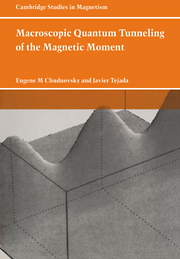Book contents
- Frontmatter
- Contents
- Preface
- Chapter I Introduction
- Chapter 2 Tunneling on a macroscopic scale
- Chapter 3 Magnetism in imaginary time
- Chapter 4 Magnetic tunneling in bulk materials
- Chapter 5 Quantum magnetic relaxation
- Chapter 6 Other experimental approaches
- Chapter 7 Tunneling in magnetic molecules
- References
- Index
Chapter 5 - Quantum magnetic relaxation
Published online by Cambridge University Press: 16 October 2009
- Frontmatter
- Contents
- Preface
- Chapter I Introduction
- Chapter 2 Tunneling on a macroscopic scale
- Chapter 3 Magnetism in imaginary time
- Chapter 4 Magnetic tunneling in bulk materials
- Chapter 5 Quantum magnetic relaxation
- Chapter 6 Other experimental approaches
- Chapter 7 Tunneling in magnetic molecules
- References
- Index
Summary
The physics of slow relaxation in solids
At a given temperature any magnetic system has a certain state that corresponds to the absolute minimum of its free energy. For a bulk ferromagnetic crystal it is a certain configuration of domains. For a system of interacting monodomain particles, it is a certain orientation of individual magnetic moments. For a superconductor it is a certain structure of the flux-line lattice, etc. In practice, however, the minimum-energy state is difficult to achieve because there are various metastable states. In spin glasses this situation is generic: the complexity of the potential makes the energy minimum physically unattainable even in a microscopic volume. In contrast, in conventional magnetic crystals the spin structure on the scale of 100–1000 Å is usually the one that minimizes local interactions. On bigger scales, however, even well-ordered systems begin to exhibit metastability. This is because grain boundaries, dislocations, impurities, etc., do not allow domain walls to move freely in order to establish the configuration of domains that corresponds to the true energy minimum. Pinning of flux lines produces a similar effect in superconductors. A separate case is a system of monodomain particles embedded within a non-magnetic solid matrix. Here each particle can be in a metastable state due to energy barriers produced by the magnetic anisotropy.
The presence of metastable states results in magnetic hysteresis. All magnetic systems that exhibit hysteresis are expected to relax slowly toward the minimum of the free energy. Note that metastability is common among non-magnetic solids as well.
- Type
- Chapter
- Information
- Macroscopic Quantum Tunneling of the Magnetic Moment , pp. 84 - 126Publisher: Cambridge University PressPrint publication year: 1998
- 1
- Cited by



